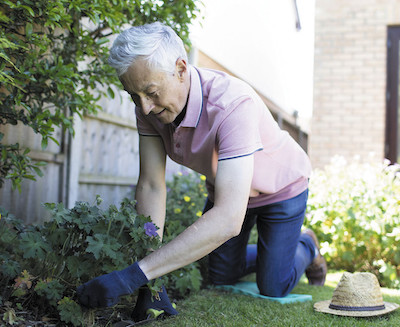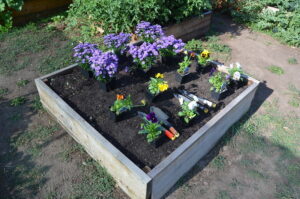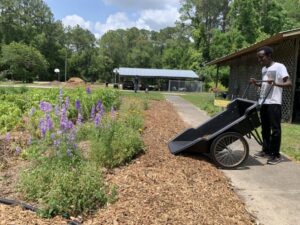Please Your Knees
by Kathleen Curthoys, Fairfax Master Gardener
 Sooner or later, no matter how much you want to keep setting out your spring seedlings and planting the pansies, your knees are going to speak up.
Sooner or later, no matter how much you want to keep setting out your spring seedlings and planting the pansies, your knees are going to speak up.
They are some of your largest joints, and they’re often the first to complain. As one experienced gardener says, “At a certain point, don’t ever get down on the ground without having a plan to get back up.”
Here are tips, techniques and tools for gardeners and their knees, based on advice from extension services.
Be good to yourself
Be thinking of ways to protect your knees from stress during a gardening session. Consider starting with about 10 minutes of stretching to help you feel physically ready for more movement. Taking a short walk or riding a bike can also warm you up.
Try to do knee-strengthening exercises regularly to build muscle for kneeling and other gardening activities. You may want to consult your doctor for stretches and exercises appropriate for you.
Limit time spent squatting or kneeling, which can strain the knees. Shift positions and postures frequently; every few minutes or so, then stand and take a few paces to keep varying the movement.
Take it easy on knees by using a kneeling pad or bench.
Wear comfortable, supportive shoes. These will be good for legs and feet and help prevent injury. Gardening in flip flops? Maybe limit that to pinching off a mint sprig for the mojito you’re going to enjoy on the deck and call it a day.
Rest frequently as you garden. Look for opportunities to set up shady spots in your garden for sitting and resting to help encourage yourself to do so.
User-friendly gardens
Raised beds
Raised beds are a versatile and accessible approach to gardening that can adapt to various levels of ability and comfort. You decide how high the raised bed should be, and how wide the platform, to suit your physical needs. At 8 to 12 inches high (20 – 30 cm), a raised bed improves access. At 2 to 3 feet high (60 – 90 cm), you may be able to garden while seated or standing without having to kneel. Add a platform along the top of the frame for easy seating.
 Consider the width, too. If the beds are 3 to 4 feet (90 – 120 cm) wide, they may be accessible from both sides without much physical exertion.
Consider the width, too. If the beds are 3 to 4 feet (90 – 120 cm) wide, they may be accessible from both sides without much physical exertion.
Raised beds offer more benefits: Water and nutrients stay within the bed. You can readily amend and add to the soil without having to dig in the yard. The soil may warm up more quickly in the spring than the ground does, potentially expanding your growing season.
Container gardening
You can choose the height and accessibility of containers and keep your gardening close to you to minimize uncomfortable positions.
Other options include planters, trellises, hanging baskets and vertical gardens in which plants are supported.
Garden tables
These shallow garden boxes, often upright on legs, can be sized to your needs. You can garden while standing to limit bending, or even while seated, as you would sit at a table. Garden tables are available to buy commercially, or you can build your own.
An added bonus is that you can put a garden table on wheels to reposition and maximize sun or shade as needed. Similarly, you can put containers on wheeled platforms for easy movement around your space.
A staircase plant stand, consisting of four or five steps with side supports, can make gardening with small containers easy. An herb garden, for example, would be easily accessible for dinner-time snipping without the need for you to lean or kneel much.
 Wheelbarrows and carts
Wheelbarrows and carts
These also expand versatility in the garden and keep supplies elevated so you spend less time close to the ground. You can also use a child’s wagon or a golf cart to pull supplies around the garden.
Tools to ease your knees
Gardener’s bench
Foldable, padded benches can be purchased at the garden center. And some of them are dual purpose: when set up and standing, the bench is about 2 to 2 1/2 feet (60 – 75 cm) from the ground with a padded surface for sitting. You can flip the bench over so that the pad is close to the ground and you can kneel on that, using the pad to cushion your knees. The legs of the bench, now upright, give you a support when it’s time to stand up.
If you don’t have a kneeler or bench, and you’re anxious to get out in the garden, even a folded-up towel will provide some improvement over the cold, hard ground.
Knee pads
Wearing these saves you from having to lug a bench around. A variety of pads are available, including those used by home improvement workers who do flooring, and those worn by athletes. Elastic around the back of the knee keeps with pads from slipping down. If you don’t like the feel of knee pads around your leg, there are also “chaps” that hang from the waist over your pants and provide a barrier between your joints and the earth.
Garden rocker seats
Not to be confused with good old rocking chairs that you’ll be planted in when your chores are done, these portable stool-type seats are ergonomically designed to let you lean while seated to reduce pressure on knees and strain on lower back. Many styles are available on the market, some with cushions for extra luxury.
Rolling garden carts and scooters
With four fat tires and generously sized swivel seats, you can roll from the rutabagas to the tomatoes with ease. Bonus: Some come with a container to store your cuttings, garden harvest or debris.
If you’re planning to garden while seated, consider bringing your long-handled tools to avoid straining the upper body as you reach to do tasks.
Push seeders
These tools lessen the need to stoop when putting out seeds in the garden since they allow the gardener to keep standing. An alternative: Use a PVC pipe with a small funnel taped to one end and drop seeds into the desired spot.
Delegate
And finally, Delegate. Got a youngster who will do some of the ground work while you supervise and repay them with your gardening wisdom and a video game gift card? Lucky you.
Resources
Getting Dirty in Your Garden: Avoiding Aches, Pains and Strains in the Garden, Lucy Bradley, North Carolina State Extension
Gardening after 50 is golden with right tools, Linda Geist, University of Missouri Extension
Gardening and Your Health: Protecting Your Knees and Back, Mary Predny, Virginia Cooperative Extension
Accessible Gardening: Raised Beds, Containers and Garden Tables, Kim Outing, North Carolina State Extension
AGRAbility –- The Toolbox Assistive Technology Database, Purdue University